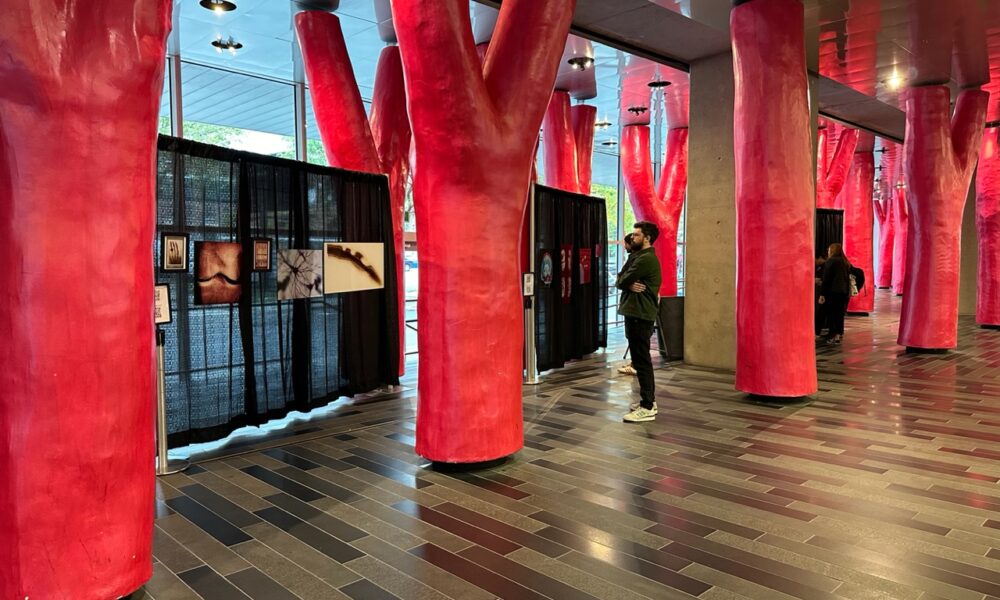From Oct. 15 to 19, the Art of Imaging exhibition showcased a remarkable collection of medical imagery created by scientists across Quebec, peeking out between the pink concrete towers of the Montreal Convention Centre’s Lipstick Forest. The exhibition by the Quebec Bio-Imaging Network (QBIN) was held during Amazing Brain Week and the World Congress of Neurology. While the exhibit’s images are no longer accessible in person, anyone can view them, along with insightful commentary in both English and French, on the QBIN website.
Captured with a wide array of techniques including Magnetic Resonance Imaging (MRI), microscopy, tomography, and ultrasounds, the images provide a glimpse of the intricate and beautiful images that many scientists work with daily.
According to Estrid Jakobsen, Communications and Student Engagement Manager for QBIN, appreciating the aesthetic value of these medical images is one of the primary purposes of the exhibition.
“A lot of science produces these really cool images, but I think a lot of scientists, because they’re so used to seeing them every day, they don’t realize just how cool they are,” Jakobsen said in an interview with The Tribune.
Jakobsen, with the support of several PhD students on QBIN’s communications committee, has been guiding the project since its inception several years ago, with various images displayed alongside a fundraiser at The Neuro. Since then, the collection of images has grown and the organizers have started using professional printing techniques, displaying them properly as artistic creations.
“What is key in the exhibit, is that they’re scientific images, but they’re really displayed and appreciated as if they were art, because of their artistic value,” Jakobsen explained. “Just by taking a scientific image and putting it in a frame, you kind of see it in a different way.”
This shift in perspective, Jakobsen argued, is crucial both for scientists and for public outreach.
“It’s good practice to take a step back from your scientific images and be like, ‘Hey, actually, these are really cool. Like, these look great,’” Jakobsen said. “When we’re stuck in our scientific viewpoints, we often lose track of the bigger picture of our research.”
For the public, highlighting the artistic value of scientific images provides a new and important way to engage with science that might otherwise be inaccessible.
“That’s part of what I do in my communications committee [is] show people why is it important that we’re doing this research, and I think art for me is a gateway into that, because so many people [that] appreciate art may not think that they appreciate science,” Jakobsen said.
In the exhibit, visitors can see everything from a stunning 3D rendering of structural connections in the human brain, created using diffusion Magnetic Resonance Imaging (dMRI), to an incredibly high-resolution scan of a mouse’s brain, created using a technique that combines ultrasound technology with the injection of millions of tiny bubbles into the mouse’s bloodstream. Each image in the collection is sure to spark wonder and curiosity.
The beauty of the exhibit’s art prints helps hook viewers in, driving them to learn more about the images and the scientific tools used to create them. This is part of the broader Open Science movement, which emphasizes tearing down barriers in science and engaging with the public, something especially critical for medicine.
“Everyone, at some point in their lives, is probably going to have an MRI scan, or an X-ray of a broken bone or something like that. And I think it’s not just important, but also cool to understand why is that happening? And what is happening?” Jakobsen said.
To further these public outreach goals, the QBIN plans to continue developing their Art of Imaging collection, in addition to their blog and their annual Scientific Day, which occurs each summer and features lectures from some of the top experts in bio-imaging from across Quebec.








